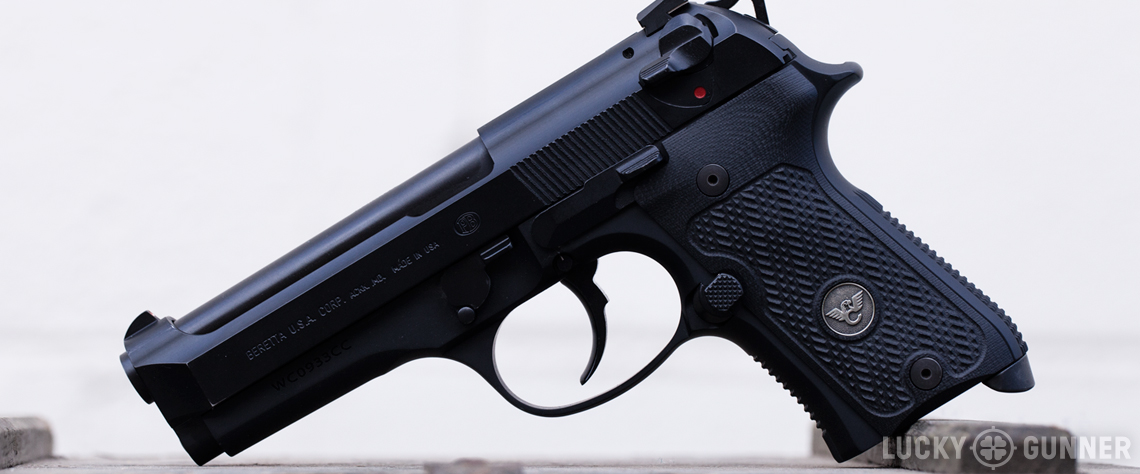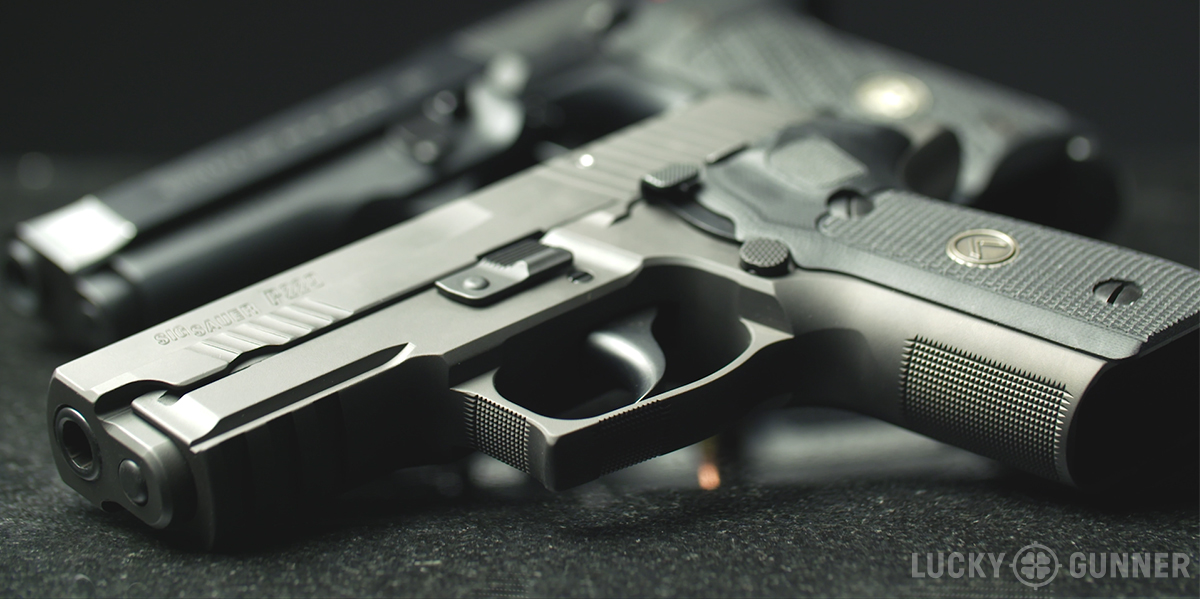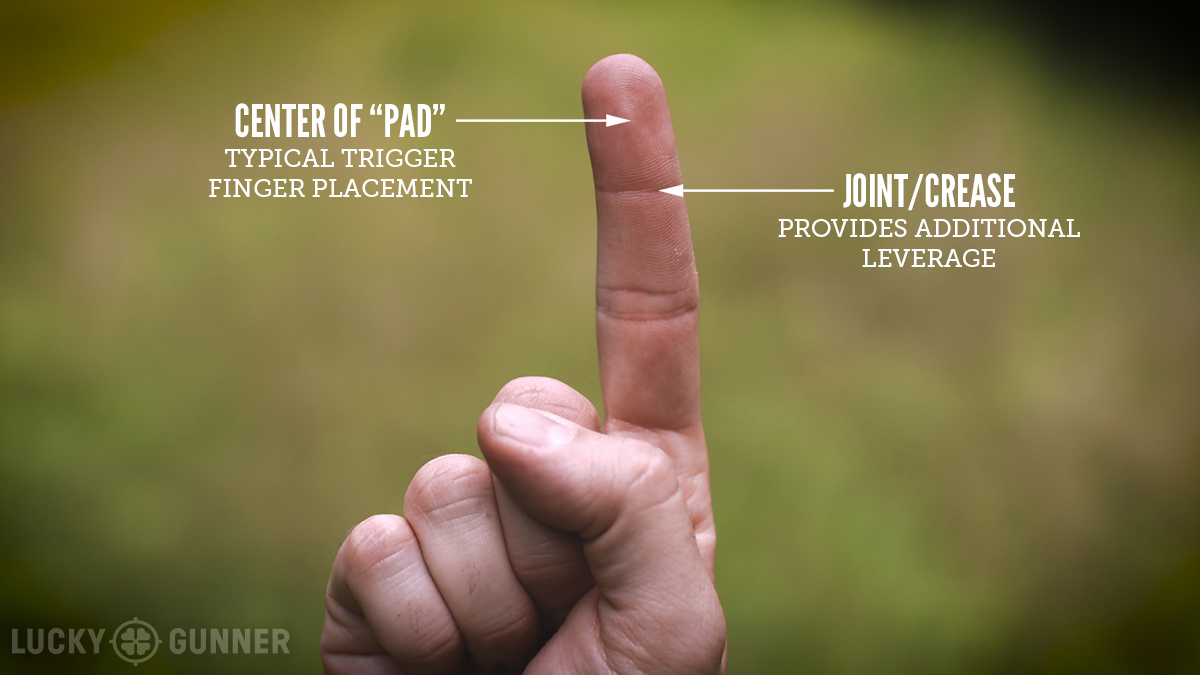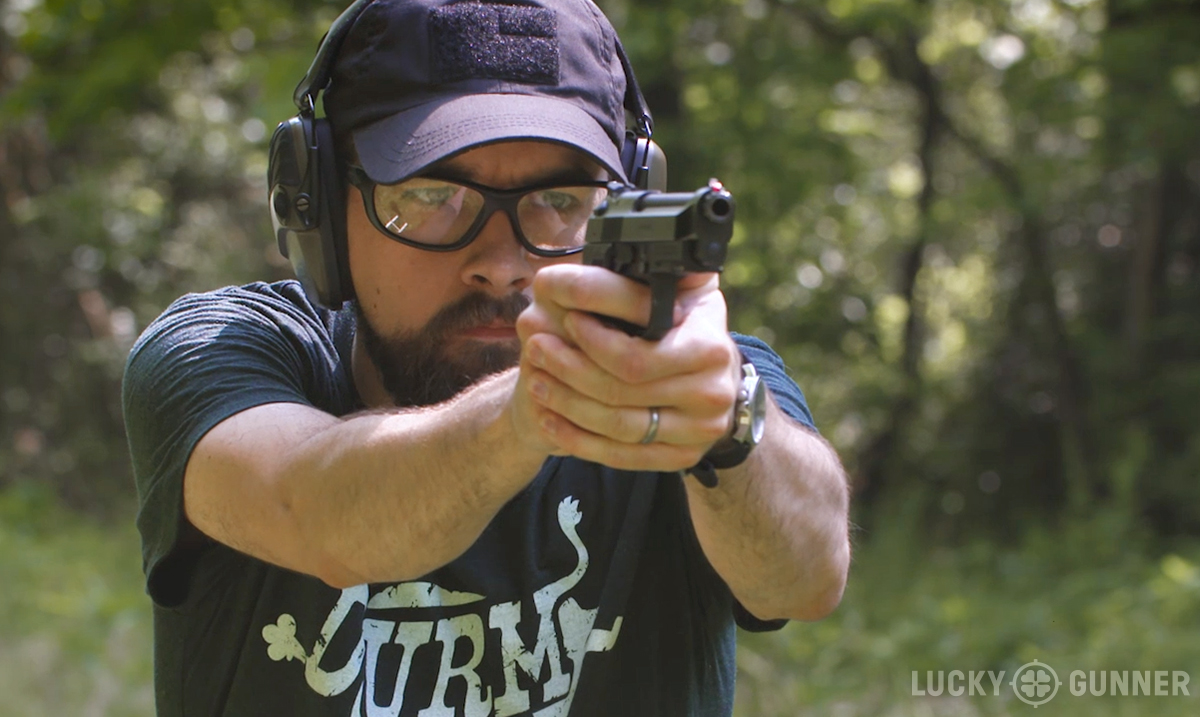As expected, feedback has been divided on my last couple of videos about double action semi-autos. There has actually been more far support than I had expected for the idea of using traditional double action autos for self-defense, but the critics have been vocal as well. Most of them assert that they would rather use a pistol with a trigger press that is consistent from one shot to the next. I can hardly blame anyone for this preference. It certainly can be easier to master a striker fired or single action pistol (though I would argue that’s not always the case — any pistol with a lousy trigger is a nightmare to use, such as the Glocks with 12 pound triggers the NYPD are forced to use).
However, becoming proficient with the double action/single action trigger is certainly doable, especially with the help of a competent instructor. As I mentioned last week, it can be difficult to find an instructor who understands how to teach the techniques required to run a double action properly. Ernest Langdon is one of the most well-known instructors with a background specializing in double action pistols. He offers several classes each year all over the US, and I highly recommend his courses if you’re looking to become a better pistol shooter (regardless of what kind of gun you’re using).
To hold you over until you’re able to train with Ernest or another reputable instructor, I’ve shared a few tips for shooting double actions in the video below. Some of these tips come straight from Ernest and the late Todd Green, another champion of DA/SA pistols, but a lot of these techniques are actually a product of my focus on revolvers last year, so there might be something in there for you wheel gun fans, too.
Learning the Double Action/Single Action Trigger
It’s pretty easy to make a case for double action pistols as a safer option than most other types of handguns, and really, the only reason they aren’t more popular is because they are challenging to shoot well. It all comes down to trigger control. You have to learn the double action trigger and then smoothly transition to the single action. In reality, it’s not as difficult as we are often led to believe. It just requires some intentional practice.
It’s only been about six months since I started the transition from primarily using striker fired pistols to using double actions for all of my personal self-defense guns, so I am by no means an expert. But I feel like I’ve started to get the hang of it, and I’ve had some good teachers, so I’m going to share a few tips that have helped me out with shooting double actions over the last few months.
The first challenge is the double action trigger itself. In order to master this, you have to actually shoot the gun double action. Some people are so intimidated by the longer and heavier trigger pull that they never actually shoot the gun this way. It’s possible for you to go to the range and just rack in the first round and now your hammer is cocked, and you could fire the whole magazine single action and never actually have to fire double action.
But if you own a double action pistol for self-defense then you have to have the discipline to decock the pistol and shoot both triggers so you can learn to run the gun the way you would if you had to draw it and shoot to defend your life. I decock the pistol after every string of fire and every drill and I never thumb cock the hammer. Whenever the gun comes off target, I decock. This is a good habit to get into anyway just for the sake of safety, but it also forces you to have to shoot that double action trigger.
The key to accurate double action shots is smooth, consistent pressure on the trigger. The best analogy I’ve heard for this comes from Wayne Dobbs, and he said the trigger stroke should be like paddling a canoe. You can do it fast or you can do it slow, but once the paddle is in the water, it’s a smooth stroke all the way through.
So that means, for close range self-defense type shooting, we have to avoid staging the trigger. That’s where you get your sights lined up and pull the trigger part of the way but that’s messed up your sights, so you’ve got to clean up the sight picture and as soon as you see what you want to see, you yank the trigger. That doesn’t usually work out very well. We have to learn how to press the trigger smoothly all the way through without stopping and without disturbing the sights.
There are a couple of things that can help out with that. First, don’t be afraid to put a little more finger on the trigger. A lot of us were taught to shoot using the first pad of our trigger finger, and that can work just fine for some people on certain guns. But with a double action pistol, sometimes you need more leverage on the trigger to get a smooth press. For me, using the first crease of my index finger on the trigger instead of the pad has really helped out a lot. What you don’t want to is use so much trigger finger that you’re wrapping it around and you curl the tip of the finger inward. That’s going to steer the gun off target every time.
No matter what part of the finger you use on the trigger, the pressure needs to go straight to the rear so you don’t disturb the sights. So I’ve just got a slight bend in my trigger finger, but not so much that I’m putting sideways pressure on the trigger.
The other thing you can try is to increase your grip pressure. I talked about this in detail in my video about how to shoot small pistols better. If you aren’t really squeezing the life out of the gun, or if you’re changing the amount of grip pressure you apply as your trigger finger moves, that’s going to hurt your recoil control, but also your ability to have a consistent trigger press from shot to shot.
Dry practice at home can really help out a lot with this, especially when you’re in the phase of figuring out a grip and trigger finger placement. It’s going to be a little different for everybody. Just work at it until you figure out a way to press the trigger without moving the gun.
Once you’re comfortable with the double action shot and you’ve got a decent draw stroke, you can start working on what’s called the press-out. That’s a technique where you begin to press the trigger as the gun is moving to full extension. Now that’s a different video for another day, but I wanted to at least mention it because its a very effective technique for using double action pistols.
Okay, now on to that transition from double action to single action. Again, I don’t think this is nearly as difficult as it is often made out to be, but there are some challenges to overcome. Even though that single action trigger is lighter and has a shorter length of travel than the double action, we can’t treat it like it’s just a light double action trigger pull. The reset point is not in the same place we started the trigger press with the first shot — it only goes back part of the way. The trigger also has a different feel to it. It’s not going to move in a smooth arc all the way through the trigger press. We’ve got some slack or pre-travel and then hard resistance before the shot breaks. This can often lead to issues with trigger control so that even if that first double action shot is a hit, the single action shot after it can often get jerked off target.
One of these issues is slapping the trigger. This is something we usually see with novice shooters. After the double action shot, they will bring their finger all the way off the trigger to the point where the trigger started and then just crash into the trigger and slap the snot out of it, and usually miss the target.
Usually, the remedy for this is to learn how to ride the reset. The double action pistol has two different trigger pulls, but the reset point is always the same after every shot. Ideally, you’re going to fire that first shot and keep your finger in constant contact with the trigger while it resets to that same point every time. And then as soon as it resets you can start taking out the slack and get ready for that next shot and press the trigger again and that way you’re never slapping the trigger off target.
Now, it’s possible to over-correct for this and you end up with the problem of pinning the trigger. This is something that Ernest Langdon talked about at length when I attended one of his classes a few weeks ago. And it doesn’t just affect double actions — almost everybody in that class was doing it at least a little bit, no matter what kind of gun they were shooting. A lot of shooters are getting way too preoccupied with riding the reset, to the point that — the way Ernest puts it is that, “you are firing the gun based on what you feel instead of what you see.” So we should be firing that next shot when we see the sights are aligned. But instead, what a lot of us are doing is keeping the trigger pinned to the rear all the way through the recoil and then holding it there and doing this slow, intentional reset after every single shot.
The result is that on a close up, wide open target where we should be able to run the trigger really fast, we’re being slowed down by trying to ride the reset. And then on a more distant target, when we get the sights lined up, we should be able to just press the trigger, but we’re having to hold the sights there for longer than we should because we have to reset and press the trigger.
Instead, we should be releasing the trigger right away. The instant the shot breaks, we can let the trigger reset and start taking out the slack so that when we see the sight picture we need to see, we can go ahead and fire again.
If that all sounds confusing to you, don’t overthink it too much. The key is just to release the trigger quickly after the shot, but then keep your finger in constant contact with the trigger so you can press it again without slapping it.
There are a lot of ways to practice the double to single action transition at the range. It can be really helpful to start off shooting two shots at a time and just decocking in between each pair. I like to use small targets for this, like 2 inch circles with no time limit. And I’ll start up close at about 3 yards and gradually work my way out to about 7 yards. Then I like to move to some drills that incorporate speed and also vary the number of shots per string. So you could try Bill Drill Version 2 – that’s where you have an 8-inch target at 7 yards with a shot timer. You go from the holster — you draw and fire one shot. Decock, reholster, draw, fire two shots. Then you do three, and then four, and then five. Then you total up your time for all five strings and that is your time to beat the next time you go out to the range.
If you work at it, before you know it, you’ll be able to run a double action pistol at least as well as any striker fired gun, so get out to the range and practice.






The advice about changing the section of the finger to use was interesting to me. I often catch myself firing from that spot because the compact I carry has a fairly small grip and it’s difficult to hook my finger into the pad position on the trigger from a draw. Fortunately it has a great trigger so I’ve never experienced any of the reset issues.
12lb Glock trigger?! Really?
Bias & falsifying statistics.
You say shooters should train with a Double Action but it sounds like you haven’t tried to master a 6lb striker. Which takes 5 min btw.
I don’t think I said what you think I said…
Mr. Richman:
NYPD officers are required to have “NY trigger” springs on their duty weapons. This configuration brings the trigger weight up to 11 or 12 pounds. It’s the reason you see all the bad shootings in NY (by which I mean inaccuracy that causes injuries to bystanders), and it doesn’t even do what it’s supposed to do, which is prevent NDs (as we found out earlier this year with the NYPD copper being convicted in a fatal ND). But it’s NYC, so what are you gonna do about it? (to quote Boss Tweed)
Great series of articles, sir. Though many will disagree with your conclusions in the high-speed, low-drag striker-fired world of contemporary gun culture, I believe that at least your approach to the issue is unassailable. Any other is irresponsible, if not foolish for a civilian who presumes to carry a gun. We all know that is the way the law will see it if the balloon ever goes up. Some will argue that training is the answer. That may well be so but only a tiny, tiny percentage of gun owners will ever spend a single day in a shooting school. If someone at your level sees a concern here, then I think there might be a concern here.
I’m a lot older than you and grew up listening to the late, great Jeff Cooper and his generation of trainers/competitors decry the DA Auto as virtually unlearnable and just not winners equipment. An entire generation of Federal agents might beg to differ. Being an inveterate (mostly because I was poor) gun trader I eventually was seduced by a brand-new P225. The double-action pull was much better than any revolver I’d ever handled and the single-action pull was almost as good. Ergonomics were a joy. It was a revelation. On my very first try at 50ft, I was able to keep the entire magazine with the first shot DA inside the black of a 50ft pistol target. I’ve never been able to as well with a Glock or anything else, though I’ve tried.
I just acquired a Walther PPQ which, I confess, was an impulse buy. I was simple stunned by how good the trigger pull was after years of trying to shoot to my potential with Glocks. I quickly discovered that it may be a little too good, and after much practice I still occasionally break the shot before I mean to. I love this gun–the trigger, the feel, the fit and finish and even the box it came in but I wouldn’t be comfortable carrying it concealed. I’m not even sure if I’d be comfortable with it beside the bed unless the chamber was left empty. Would the owners of tuned 1911’s be comfortable without a thumb safety? Ol’ Jeff would call that Condition Stupid. I’m not sure if I’ve made your point here or any point for that matter, but my mind is open. Again, I appreciate your refreshingly analytical, tolerant approach and do not miss the juvenile macho posturing so common on blogs like this. Hey, if you’re really all that you should be trying to help people up to your level instead of berating theirs.
Thanks for this series….looking to purchase my first firearm, given me lots to think about. Specifically, the info here has reinforced my belief that even more important than the physical specs of any weapon I might be interested in is the collective attributes that will make a hand gun comfortable for me.
Excellent series. I rarely carry and my primary use is Home Defense and sport shooting. I understand that DA/SA is not for everyone. I have both DA/SA and striker handguns. My CZ 75 SP-01 requires careful manual de-cocking to engage the DA 1st round and I had only used in SA with manual safety cocked and locked. But I’ve since obtained a CZ-2075 Rami BD and Stoeger Cougar (Beretta 8000) that each have the de-cocking lever…Much safer to engage DA. In retrospect; I wish I had gotten the CZ-75 SP-01 Tactical; with the de-cocking lever, or a CZ P-01 Omega that gives you the choice of both manual safety or de-cocker. Although I shoot my HK VP-9 and Glock 17 slightly better in quick-fire; now that I’m practicing the DA/SA mode; I’ve been considering that for me, the DA 1st round might be my safest choice when my adrenaline is pumping. Thanks again for this thought provoking article, and training suggestions.
P.S. Tried your trigger suggestions at the range and I saw much improvement with the DA 1st round and continued with the 1-2-3-4-5 follow-up exercise. After several days practice, compared shooting my HK VP9 striker against the CZ-SP-01 DA/SA and was pleased to see equal on-target results shooting in DA 1st round. Thanks again Chris!
I’ve just finished watching your three video series on DA/SA pistols. Excellent job! I started off as a target shooter in the 70’s and moved into law enforcement at about the same time, so I lived through multiple transitions and different schools of thought regarding pistols. Back then, many of us liked the short and consistent trigger of the 1911, but generally not for on-duty use, because as cops we held a lot more people at gunpoint than we shot, and the 1911 was not a great threat management pistol for most people, although you could certainly use it for that with a lot of training. But, like you, even though I was shooting several times a week, and competing with the 1911, I did find myself making mistakes that would only be amplified by the stress of an actual encounter.
What a lot of younger people don’t realize is that the DA/SA automatic was an integral part of the switch to autopistols in law enforcement. We were used to our DA revolvers, which had a long, heavy shot for each round fired. When we got SIG’s or Beretta’s and only had to put up with that for the first shot in an emergency, many of us thought we had died and gone to heaven. It’s funny, I was a police firearms trainer, and it was not until we were into the “Glock era” for about 15 years that i heard anyone whining about how hard it was to manage a DA/SA firearm. We used to teach it to cops in less than a day. I guess you learn what you have to learn. People act as though someone who can figure out complex shoot/no shoot scenarios will somehow be mystified by a different trigger pull for the first shot, or by a decocking lever.
I think many of the arguments leveled against the traditional DA/SA pistol come from people who grew up on striker fired handguns and know nothing else, and fail to realize, as you have correctly pointed out, some of the safety advantages of a DA first shot. The striker fired pistols are great, and certainly easier to shoot, but ease of shooting is not the only metric by which a defensive firearm should be judged.
These are really good videos!
I must be in the minority, but I have never had an issue transitioning between DA/SA trigger pulls. Ignoring, of course, some triggers being horrible to use due to weight, creep, stacking, etc.